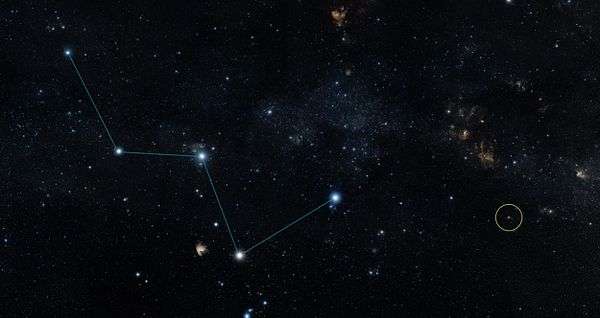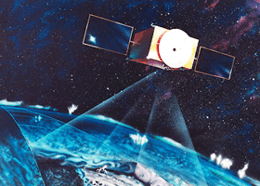HR 8832
 Star HR 8832 (circled) lies just off the "W" shape of the constellation Cassiopeia. | |
| Observation data Epoch J2000 Equinox J2000 | |
|---|---|
| Constellation | Cassiopeia |
| Right ascension | 23h 13m 16.97632s[1] |
| Declination | +57° 10′ 06.0823″[1] |
| Apparent magnitude (V) | 5.574[2] |
| Characteristics | |
| Spectral type | K3V[3] |
| U−B color index | +0.902[2] |
| B−V color index | +0.983[2] |
| Variable type | Suspected[4] |
| Astrometry | |
| Radial velocity (Rv) | –18.5[5] km/s |
| Proper motion (μ) | RA: +2075.07±0.33[1] mas/yr Dec.: +295.45±0.25[1] mas/yr |
| Parallax (π) | 152.76 ± 0.29[1] mas |
| Distance | 21.35 ± 0.04 ly (6.55 ± 0.01 pc) |
| Absolute magnitude (MV) | 6.46[6] |
| Details | |
| Mass | 0.794+0.037 −0.022[7] M☉ |
| Radius | 0.80±0.04[8] R☉ |
| Luminosity | 0.28[note 1] L☉ |
| Surface gravity (log g) | 4.50[3] cgs |
| Temperature | 4710[3] K |
| Metallicity [Fe/H] | +0.20[3] dex |
| Rotational velocity (v sin i) | 6.94[9] km/s |
| Age | ~12.46[7] Gyr |
| Other designations | |
| Database references | |
| SIMBAD | data |
HR 8832 (or HD 219134, or Gliese 892) is a main sequence star in the constellation of Cassiopeia. It is smaller and less luminous than our Sun, with a spectral class of K3V, which makes it an orange-red hued star. HR 8832 is relatively close to our system, with an estimated distance of 21.25 light years. This star is close to the limit of apparent magnitude that can still be seen by the unaided eye. The limit is considered to be magnitude 6 for most observers.
This star has a magnitude 9.4 companion at an angular separation of 106.6 arcseconds.[11] The star is reported to host a rocky super-Earth, HD 219134 b, based on size (1.6 times the size of Earth), and density (6 grams per cubic cm).[12][13] A further three exoplanets, two super-Earths and one Jovian world, have been deduced using Harps-N radial velocity data.[14] Two more were discovered two months later.[15]
Planetary system
| Companion (in order from star) |
Mass | Semimajor axis (AU) |
Orbital period (days) |
Eccentricity | Inclination | Radius |
|---|---|---|---|---|---|---|
| b | 0.012±0.001 MJ | 0.038474±8e-07 | 3.0931±0.0001 | 0.0+0.13 −0.0 |
85.058±0.08° | 0.1433±0.0077 RJ |
| c | 0.011±0.002 MJ | 0.064816±4e-06 | 6.7635±0.0006 | 0.0+0.26 −0.0 |
— | — |
| f | 0.028±0.003 MJ | 0.14574±2e-05 | 22.805±0.005 | 0.0 | — | — |
| d | 0.067±0.004 MJ | 0.23508±4e-06 | 46.71±0.01 | 0.0 | — | — |
| g | 0.034±0.004 MJ | 0.3753±0.0004 | 94.2±0.2 | — | — | — |
| e | 0.0117+0.19 −0.006 MJ |
2.56+3.41 −0.15 |
1842.0+4199.0 −292.0 |
0.34±0.17 | — | — |
| h | 0.34 MJ | 3.11±0.04 | 2247.0±43.0 | 0.06±0.04 | — | — |
References
- 1 2 3 4 5 van Leeuwen, F. (November 2007), "Validation of the new Hipparcos reduction", Astronomy and Astrophysics, 474 (2): 653–664, Bibcode:2007A&A...474..653V, arXiv:0708.1752
 , doi:10.1051/0004-6361:20078357.
, doi:10.1051/0004-6361:20078357. - 1 2 3 Oja, T. (August 1986), "UBV photometry of stars whose positions are accurately known. III", Astronomy and Astrophysics Supplement Series, 65 (2): 405–409, Bibcode:1986A&AS...65..405O.
- 1 2 3 4 Frasca, A.; et al. (December 2009), "REM near-IR and optical photometric monitoring of pre-main sequence stars in Orion. Rotation periods and starspot parameters", Astronomy and Astrophysics, 508 (3): 1313–1330, Bibcode:2009A&A...508.1313F, doi:10.1051/0004-6361/200913327.
- ↑ Kukarkin, B. V.; et al. (1981), "Nachrichtenblatt der Vereinigung der Sternfreunde e.V. (Catalogue of suspected variable stars)", Nachrichtenblatt der Vereinigung der Sternfreunde e.V. (1981), Moscow: Academy of Sciences USSR Shternberg: 0, Bibcode:1981CSV...C......0K.
- ↑ Wielen, R.; et al. (1999), "Sixth Catalogue of Fundamental Stars (FK6). Part I. Basic fundamental stars with direct solutions", Veröff. Astron. Rechen-Inst. Heidelb, Astronomisches Rechen-Institut Heidelberg, 35 (35): 1, Bibcode:1999VeARI..35....1W.
- ↑ Holmberg, J.; et al. (July 2009), "The Geneva-Copenhagen survey of the solar neighbourhood. III. Improved distances, ages, and kinematics", Astronomy and Astrophysics, 501 (3): 941–947, Bibcode:2009A&A...501..941H, arXiv:0811.3982
 , doi:10.1051/0004-6361/200811191.
, doi:10.1051/0004-6361/200811191. - 1 2 Takeda, Genya; et al. (February 2007), "Structure and Evolution of Nearby Stars with Planets. II. Physical Properties of ~1000 Cool Stars from the SPOCS Catalog", The Astrophysical Journal Supplement Series, 168 (2): 297–318, Bibcode:2007ApJS..168..297T, arXiv:astro-ph/0607235
 , doi:10.1086/509763.
, doi:10.1086/509763. - ↑ Perrin, M.-N.; Karoji, H. (1987), "Stellar radius determination from IRAS 12-micron fluxes", Astronomy and Astrophysics, 172: 235–240, Bibcode:1987A&A...172..235P.
- ↑ Martínez-Arnáiz, R.; et al. (September 2010), "Chromospheric activity and rotation of FGK stars in the solar vicinity. An estimation of the radial velocity jitter", Astronomy and Astrophysics, 520: A79, Bibcode:2010A&A...520A..79M, arXiv:1002.4391
 , doi:10.1051/0004-6361/200913725.
, doi:10.1051/0004-6361/200913725. - ↑ "HR 8832 -- Flare Star", SIMBAD Astronomical Object Database, Centre de Données astronomiques de Strasbourg, retrieved 2012-04-08.
- ↑ Eggleton, P. P.; Tokovinin, A. A. (September 2008), "A catalogue of multiplicity among bright stellar systems", Monthly Notices of the Royal Astronomical Society, 389 (2): 869–879, Bibcode:2008MNRAS.389..869E, arXiv:0806.2878
 , doi:10.1111/j.1365-2966.2008.13596.x.
, doi:10.1111/j.1365-2966.2008.13596.x. - ↑ "PIA19832: Location of Nearest Rocky Exoplanet Known". NASA. 30 July 2015. Retrieved 30 July 2015.
- ↑ Chou, Felicia; Clavin, Whitney (30 July 2015). "NASA's Spitzer Confirms Closest Rocky Exoplanet". NASA. Retrieved 31 July 2015.
- ↑ "Cassiopeia's Hidden Gem". Harvard. 30 July 2015. Retrieved 30 July 2015.
- ↑ Vogt; et al. (25 September 2015). "A Six-Planet System Orbiting HD 219134". arXiv:1509.07912
 [astro-ph.EP].
[astro-ph.EP]. - ↑ http://exoplanet.eu/catalog/hd_219134_b/
- ↑ http://exoplanet.eu/catalog/hd_219134_c/
- ↑ http://exoplanet.eu/catalog/hd_219134_d/
- ↑ http://exoplanet.eu/catalog/hd_219134_e/
- ↑ "Planet HD 219134 f". Exoplanet.eu. Retrieved 2015-11-17.
- ↑ "Planet HD 219134 g". Exoplanet.eu. Retrieved 2015-11-17.
- ↑ "Planet HD 219134 h". Exoplanet.eu. Retrieved 2015-11-17.
Notes
- ↑ From , where is the luminosity, is the radius, is the effective surface temperature and is the Stefan–Boltzmann constant
External links
- "BD+56 2966 / HR 8832". SolStation. Retrieved November 7, 2005.
Coordinates: ![]() 23h 13m 16.98s, +57° 10′ 06.1″
23h 13m 16.98s, +57° 10′ 06.1″


